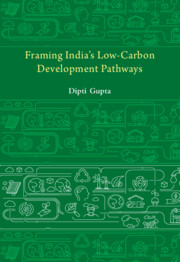Book contents
- Frontmatter
- Contents
- List of figures
- List of tables
- Prologue
- Acknowledgements
- List of abbreviations
- 1 Achieving Net Zero: A Wicked Problem for India
- 2 Themes for Exploring Low-Carbon Pathways
- 3 Building a Hybrid Dataset for Modelling Low-Carbon Pathway
- 4 Bottom-Up Approach and Technology Details
- 5 Macroeconomic Framing of Energy Systems in India Using Simulations
- 6 Top-Down Approach: Multi-Sector Economy-Wide Model
- 7 Scenario Construction and Pathways Analysis
- 8 Sectoral Case Study: Application of Hybrid Approach to Economy-Wide Analysis
- 9 Sectoral Case Study: Application of the Hybrid Modelling Approach to the Transport Sector
- 10 Conclusion: Other Applications, Policy Insights, and Road Ahead
- Index
Prologue
Published online by Cambridge University Press: 15 July 2025
- Frontmatter
- Contents
- List of figures
- List of tables
- Prologue
- Acknowledgements
- List of abbreviations
- 1 Achieving Net Zero: A Wicked Problem for India
- 2 Themes for Exploring Low-Carbon Pathways
- 3 Building a Hybrid Dataset for Modelling Low-Carbon Pathway
- 4 Bottom-Up Approach and Technology Details
- 5 Macroeconomic Framing of Energy Systems in India Using Simulations
- 6 Top-Down Approach: Multi-Sector Economy-Wide Model
- 7 Scenario Construction and Pathways Analysis
- 8 Sectoral Case Study: Application of Hybrid Approach to Economy-Wide Analysis
- 9 Sectoral Case Study: Application of the Hybrid Modelling Approach to the Transport Sector
- 10 Conclusion: Other Applications, Policy Insights, and Road Ahead
- Index
Summary
Motivation
The year 2015 marked the occurrence of two landmark events—signing of the Paris Agreement for limiting the temperature rise to below 2°C and adoption of 2030 Agenda for Sustainable Development. Further to this Intergovernmental Panel on Climate Change (IPCC), intergovernmental body of the United Nations, released the special report on global warming of 1.5oC that outlined the dire consequences of not taking timely action towards mitigating global emissions. Government of India has ratified the climate change agreement and is required to regularly update the long term low-emission development strategy in accordance with the Article 4 of the agreement. Energy sector is the major source of greenhouse gas emissions and therefore requires special attention so as to achieve the net zero emission targets for the economy. This will entail scenario planning and a rigorous approach to modelling the pathways so that they can represent reality to the extent possible.
Before the adoption of Paris agreement, national emission mitigation was determined using the global models. In other words, the national context played lesser role in estimating the long-term emission reduction rather reduction potential was imposed from the top. However, with the adoption of Paris Agreement, domestic context played a vital role and the proposed idea was that the reduction potential is better governed by the national models. This led to the call for strengthening the national modelling capacity that can provide national emission mitigation pathways under the constraint of global barriers and enablers. National accounts and energy balance derived from the bottom-up models should feed into the top-down domestic economy wide models rather than just relying on the global integrated assessment models.
Information
- Type
- Chapter
- Information
- Framing India's Low Carbon Development Pathways , pp. xix - xxiiPublisher: Cambridge University PressPrint publication year: 2025
